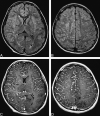"Ivy sign" on fluid-attenuated inversion-recovery images in childhood moyamoya disease
- PMID: 10588105
- PMCID: PMC7657767
"Ivy sign" on fluid-attenuated inversion-recovery images in childhood moyamoya disease
Abstract
We report on MR studies of a 15-year-old girl with moyamoya disease in whom diffuse leptomeningeal enhancement ("ivy sign") was revealed by fluid-attenuated inversion-recovery (FLAIR) and contrast-enhanced imaging. We speculate that the mechanism behind this enhancement is caused by a retrograde slow flow of engorged pial vasculature via leptomeningeal anastomosis. Nevertheless, it remains unknown whether the precise source of a high signal on FLAIR images is attributable to pial vessels themselves or congested thickening of the leptomeninges or both.
Figures

Similar articles
-
Leptomeningeal high signal intensity (ivy sign) on fluid-attenuated inversion-recovery (FLAIR) MR images in moyamoya disease.Eur J Radiol. 2005 Aug;55(2):224-30. doi: 10.1016/j.ejrad.2004.11.009. Epub 2004 Dec 28. Eur J Radiol. 2005. PMID: 16036151
-
"Ivy sign" in childhood moyamoya disease: depiction on FLAIR and contrast-enhanced T1-weighted MR images.Radiology. 2002 May;223(2):384-9. doi: 10.1148/radiol.2232011094. Radiology. 2002. PMID: 11997541
-
Diffuse leptomeningeal enhancement, "ivy sign," in magnetic resonance images of moyamoya disease in childhood: case report.Neurosurgery. 1995 Nov;37(5):1009-12. doi: 10.1227/00006123-199511000-00024. Neurosurgery. 1995. PMID: 8559324
-
The leptomeningeal "ivy sign" on fluid-attenuated inversion recovery MR imaging in Moyamoya disease: a sign of decreased cerebral vascular reserve?AJNR Am J Neuroradiol. 2009 May;30(5):930-5. doi: 10.3174/ajnr.A1504. Epub 2009 Feb 26. AJNR Am J Neuroradiol. 2009. PMID: 19246527 Free PMC article.
-
Unilateral hemispheric proliferation of ivy sign on fluid-attenuated inversion recovery images in moyamoya disease correlates highly with ipsilateral hemispheric decrease of cerebrovascular reserve.AJNR Am J Neuroradiol. 2009 Oct;30(9):1709-16. doi: 10.3174/ajnr.A1679. Epub 2009 Aug 27. AJNR Am J Neuroradiol. 2009. PMID: 19713323 Free PMC article.
Cited by
-
Complications of Radiotherapy and Radiosurgery in the Brain and Spine.Neurographics (2011). 2018 Jun;8(3):167-187. doi: 10.3174/ng.1700066. Neurographics (2011). 2018. PMID: 35388375 Free PMC article.
-
Usefulness of Contrast-Enhanced 3D-FLAIR MR Imaging for Differentiating Rathke Cleft Cyst from Cystic Craniopharyngioma.AJNR Am J Neuroradiol. 2020 Jan;41(1):106-110. doi: 10.3174/ajnr.A6359. Epub 2019 Dec 19. AJNR Am J Neuroradiol. 2020. PMID: 31857323 Free PMC article.
-
FLAIR Hyperintense Vessel Sign of Both MCAs with Severe Heart Failure.Case Rep Neurol Med. 2016;2016:5169056. doi: 10.1155/2016/5169056. Epub 2016 Aug 25. Case Rep Neurol Med. 2016. PMID: 27648320 Free PMC article.
-
Ivy Sign on Fluid-Attenuated Inversion Recovery Images in Moyamoya Disease: Correlation with Clinical Severity and Old Brain Lesions.Yonsei Med J. 2015 Sep;56(5):1322-7. doi: 10.3349/ymj.2015.56.5.1322. Yonsei Med J. 2015. PMID: 26256975 Free PMC article.
-
Perfusion MR neuroimaging in patients undergoing balloon test occlusion of the internal carotid artery.AJNR Am J Neuroradiol. 2001 Sep;22(8):1590-6. AJNR Am J Neuroradiol. 2001. PMID: 11559513 Free PMC article.
References
-
- Ohta T, Tanaka H, Kuroiwa T, Diffuse leptomeningeal enhancement, “ivy sign,” in magnetic resonance images of moyamoya disease in childhood: case report. Neurosurgery 1995;37:1009-1012 - PubMed
-
- Suzuki J, Takaku A, Cerebral vascular ‘moyamoya’ disease. A disease showing abnormal net-like vessels in base of brain. Arch Neurol 1969;20:288-299 - PubMed
Publication types
MeSH terms
LinkOut - more resources
Full Text Sources
Medical
